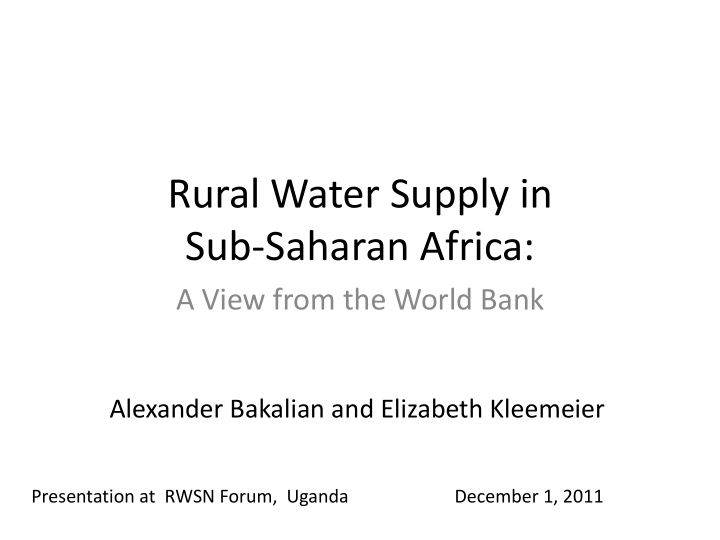



Rural Water Supply in Sub-Saharan Africa: A View from the World Bank Alexander Bakalian and Elizabeth Kleemeier Presentation at RWSN Forum, Uganda December 1, 2011
Contents 1. RWS Sector Overview in SSA 2. Drivers of Access 3. Barriers to Access 4. World Bank projects in RWS in SSA 5. A strategic vision for future Bank engagement 6. Summing up 2
1. Overview: Improved Rural Water Supplies in Sub-Saharan Africa 3
Significant progress in improved rural water access, 1990- 2008… but great need remains 47% served 36% served Source: WHO/UNICEF Joint Monitoring Programme for Water Supply and Sanitation at: http://www.wssinfo.org/data-estimates/graphs/ 4
Disparities: Rural water access lags behind urban water 83% served 47% served Source: WHO/UNICEF Joint Monitoring Programme for Water Supply and Sanitation at: 5 http://www.wssinfo.org/data-estimates/graphs/
Disparities: Significant differences among countries in rural water access 0% 50% 75% Source: WHO/UNICEF Joint Monitoring Programme for Water Supply and Sanitation at: 6 http://www.wssinfo.org/data-estimates/graphs/
2. Drivers of Access 7
Political Economy Drove Access Political Economy Classification Type of Political Countries Economy Burundi, CAR, DRC. Cote d’Ivoire, Gambia, Low-income fragile Liberia, Sierra Leone, Togo, Zimbabwe Benin, Burkina Faso, Ethiopia, Ghana, Low-income non- Kenya, Madagascar, Malawi, Mali, fragile Mauritania, Mozambique, Niger, Rwanda, Senegal, Tanzania, Uganda Angola, Cameroon, Chad, Congo Resource rich Brazzaville, Nigeria, Sudan, Zambia Middle income South Africa Classification from IMF. 2007. Regional Economic Outlook, Sub-Saharan Africa 8
Low income, stable countries made the most progress Increase in Rural Water Supply Coverage, 1990 - 2008 20% 18% 16% 14% 12% 10% 8% 6% 4% 2% 0% LIC fragile LIC non- Resource South Africa fragile rich Source: AMCOW Country Status Overviews, pg. 32 at: 9 http://www.wsp.org/wsp/sites/wsp.org/files/publications/CSO-Synthesis-Report.pdf
Low-income, stable countries received much more aid (more on urban than rural) Source: AMCOW Country Status Overviews, pg. 36 at: 10 http://www.wsp.org/wsp/sites/wsp.org/files/publications/CSO-Synthesis-Report.pdf
3. Barriers to Access 11
Investment funds insufficient for low income countries Spending Needs to Close MDG Coverage Gap for Water Supply and Sanitation Annual share US $ millions Type of Political of GDP (%) per year Economy 2001-2005 Needed 2001-2005 Needed Low income fragile 1.1 11.8 441 4,437 Low income non- 1.7 7.1 1,840 7,810 fragile Resource rich 1.0 2.9 2,637 6,364 Middle income 0.8 1.5 1,753 3,976 Source: Sudeshna Ghosh Banerjee and Elvira Morella. 2011. Africa’s Water and Sanitation Infrastructure . World Bank. Pg. 205, 216 12
Time needed to meet MDG targets with today’s budget envelopes Years taken to reach MDG target MIC RR LICNF LICF (counting from 2006) Existing spending only >30 >30 >30 >30 Existing spending plus efficiency >30 >30 <10 26 gains
Poor maintenance Breakdown rates in rural water supplies Percentage Data Source Type of Rural Supply Non-functioning RWSN Handpumps 30 World Bank 2009 Handpumps 25 Mechanized World Bank 2009 Boreholes & Piped 25 Schemes World Bank 2007 Rural Water Points 24 See notes page for sources 14
4. World Bank investment projects in rural water supply and sanitation in Sub-Saharan Africa
Ongoing or recently completed RWSS operations in 9 countries Ghana , Tanzania , Ethiopia , South Sudan , and Senegal are the big RWSS operations Overview -- 17
List of Operations with RWSS Components US millions RWSS Total Country Component Operations Ethiopia Water Supply and Sanitation 51 180 Ghana Small Towns 51 51 Ghana Sustainable Rural Water Supply and Sanitation 75 75 Malawi National Water Development II 11 75 Niger Water Sector 7 58 Senegal Water and Sanitation Millennium 36 55 Sierra Leone Power and Water 9 28 Sudan Water Supply and Sanitation 45 45 Tanzania Water Sector Support 60 200 Zambia Water Sector Performance Improvement 1 23 Total 346 790
Overview – Implementation Period Country 2001 2002 2003 2004 2005 2006 2007 2008 2009 2010 2011 2012 2013 2014 2015 2016 Malawi Niger Sierra Leone Zambia Countries have major AFTUW RWSS operations Overview -- 19
5. Looking into the future: a strategic vision
What the World Bank will do: some preliminary building blocks (1) 1. Focus on Results in terms of outputs and outcomes 2. Mobilize increased lending by leveraging external partnerships (conventional and new partners) 3. Work across sectors – health, education, income producing activities, etc, to increase the visibility of the sector 21
What the World Bank will do: some preliminary building blocks (2) 4. Maintain knowledge enhancement – focus on evidence-based interventions (more impact evaluations) and collaboration on research 5. Move project towards programmatic lending once intervention models are found to deliver results 22
What the World Bank will do: some preliminary building blocks (3) 6. Investing in understanding the world of political economy 7. Investing in capacity building 8. Embedding technology, behavior, resources in country systems approach 23
Framework for results Focusing on Availability of Strong client Strong most promising required ownership Partnerships projects capacity • Ensure • Develop new • Demonstrated • Stakeholder sufficient time and innovative willingness to participation for project • Multi-Donor solutions (e.g. lead policy and preparation ICT) design of approaches • Engage where • Leverage private • Explore new programs required • Strong, investment types of • Close capacities can capable client partnerships be made information gap teams available through research
Structural Issues that need to be addressed – food for thought for RWSN • Long-term financial sustainability to replace infrastructure at the end of the economic life • Ability to expand capacity to accommodate population and economic growth 25
Summing up… • Programmatic approaches are needed to deliver results ; leverage and partnerships are necessary • Good governance, social accountability and capacity building (at all levels) will ensure sustainable outcomes on access, service quality and financial viability • Rural water remains a major development issue which needs the continued active engagement of governments and non-government organizations 26
Recommend
More recommend